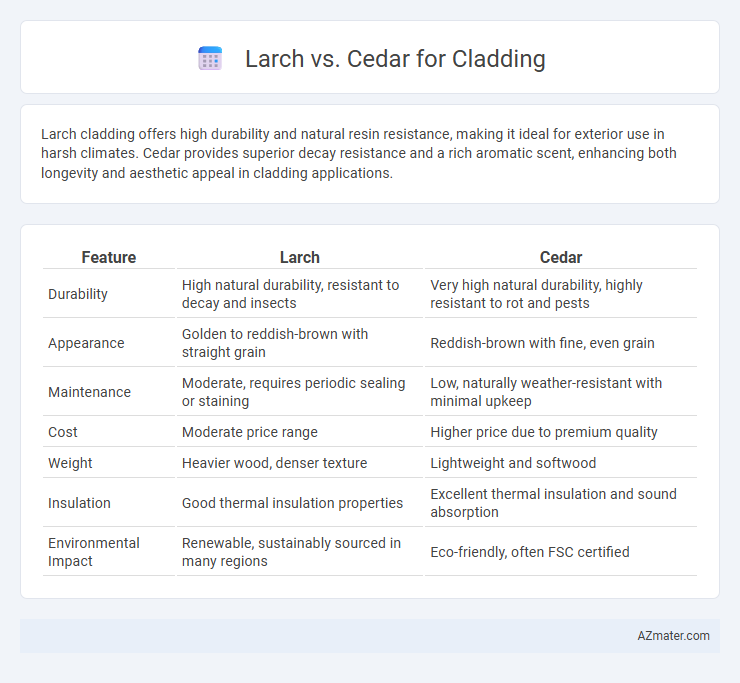Larch cladding offers high durability and natural resin resistance, making it ideal for exterior use in harsh climates. Cedar provides superior decay resistance and a rich aromatic scent, enhancing both longevity and aesthetic appeal in cladding applications.
Table of Comparison
| Feature | Larch | Cedar |
|---|---|---|
| Durability | High natural durability, resistant to decay and insects | Very high natural durability, highly resistant to rot and pests |
| Appearance | Golden to reddish-brown with straight grain | Reddish-brown with fine, even grain |
| Maintenance | Moderate, requires periodic sealing or staining | Low, naturally weather-resistant with minimal upkeep |
| Cost | Moderate price range | Higher price due to premium quality |
| Weight | Heavier wood, denser texture | Lightweight and softwood |
| Insulation | Good thermal insulation properties | Excellent thermal insulation and sound absorption |
| Environmental Impact | Renewable, sustainably sourced in many regions | Eco-friendly, often FSC certified |
Introduction to Larch and Cedar Cladding
Larch cladding offers exceptional durability, natural resistance to decay, and a distinctive warm hue that enhances exterior aesthetics. Cedar cladding is renowned for its lightweight properties, superior insulation, and inherent resistance to moisture and pests, making it ideal for various climates. Both woods provide eco-friendly options with unique textures and color variations suited for sustainable architectural designs.
Key Differences Between Larch and Cedar Wood
Larch wood is denser and more resinous than cedar, providing superior durability and resistance to moisture, making it ideal for cladding in wet climates. Cedar offers natural oils that resist rot and insect damage, combined with a lighter weight and smoother texture, which facilitates easier installation and maintenance. While larch ages to a silvery gray hue with time, cedar retains a warm reddish-brown tone, influencing aesthetic choices in exterior siding applications.
Durability and Lifespan Comparison
Larch wood offers high natural durability due to its dense grain and resin content, making it resistant to rot and insect damage, suitable for cladding in harsh weather conditions. Cedar, known for its exceptional longevity and inherent resistance to moisture and decay, typically lasts 20-30 years longer than many softwoods when used as exterior cladding. Both woods provide excellent durability, but cedar's natural oils give it a longer lifespan and lower maintenance requirements compared to larch.
Weather Resistance and Maintenance Needs
Larch offers superior weather resistance due to its dense resin content, making it highly durable against moisture and decay in exterior cladding applications. Cedar, while naturally rich in oils that repel insects and resist rot, requires more frequent maintenance to preserve its protective qualities and prevent surface weathering. Both woods provide excellent aesthetics, but larch's lower maintenance and enhanced moisture resistance make it a preferred choice for long-lasting cladding in harsh climates.
Appearance and Color Variations
Larch wood features a warm, golden-brown hue with natural resin streaks that evolve into a silvery-gray patina over time, offering dynamic color variations that enhance rustic and contemporary facades. Cedar displays rich reddish-brown tones with subtle pink and amber highlights, providing a uniform and luxurious appearance that deepens with age while resisting weathering. Both woods offer distinct aesthetic qualities for cladding, with Larch showcasing a textured, rugged look and Cedar delivering a smooth, elegant finish ideal for diverse architectural styles.
Environmental Impact and Sustainability
Larch and cedar both offer sustainable options for cladding, with larch being a fast-growing, locally sourced softwood that reduces carbon footprint through shorter transportation distances. Cedar's natural resistance to decay and pests extends its lifespan, minimizing replacement frequency and waste generation. Life cycle assessments show that responsibly harvested larch generally has a lower environmental impact due to its rapid growth and efficient sequestration of carbon compared to cedar.
Cost Comparison: Larch vs Cedar
Larch cladding typically costs less upfront than cedar, with prices averaging $3 to $7 per square foot compared to cedar's $4 to $8 per square foot. Larch offers a durable, weather-resistant option that may reduce long-term maintenance expenses, while cedar's natural oils provide superior rot resistance, potentially lowering replacement costs. Budget considerations often balance the initial savings of larch against cedar's premium price and enhanced longevity, influencing the overall investment in exterior cladding.
Ease of Installation and Workability
Larch wood offers excellent workability due to its fine grain and moderate density, enabling easier cutting, nailing, and fastening during cladding installation. Cedar's lighter weight and natural softness also contribute to ease of installation, making it simpler to handle and shape on-site. Both woods provide user-friendly properties, but larch's durability combined with manageable hardness often results in a more straightforward installation process for exterior cladding projects.
Applications and Suitability for Various Projects
Larch offers excellent durability and natural resistance to decay, making it ideal for exterior cladding in harsh weather conditions and coastal environments. Cedar's lightweight nature and superior dimensional stability provide enhanced insulation and a smooth finish, suitable for residential and high-end architectural projects. Both timbers excel in sustainability, but project requirements such as exposure, aesthetic preference, and maintenance influence the choice between Larch and Cedar for cladding applications.
Which is Better for Cladding: Larch or Cedar?
Larch offers exceptional durability and resistance to rot, making it an ideal choice for cladding in harsh weather conditions, while its dense grain provides a natural water-resistant barrier. Cedar is prized for its excellent stability, natural oils that resist insects and decay, and its lightweight texture, allowing for easier installation and long-lasting performance. For cladding, larch tends to be better for structural resilience and weather endurance, whereas cedar excels in aesthetic appeal and ease of maintenance.

Infographic: Larch vs Cedar for Cladding
 azmater.com
azmater.com